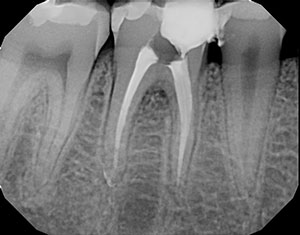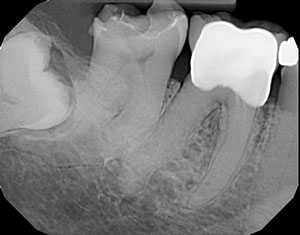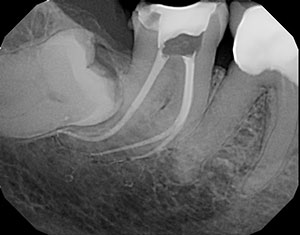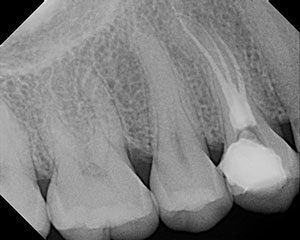
As endodontists—or as dentists, for that matter—we should all strive to be conservative or minimally invasive. I have never heard of a dentist who intentionally wants to be maximally invasive!
Minimally invasive endodontics (MIE) is a concept that refers to the minimal removal of dentin during the 3 phases of endodontic therapy: the coronal access preparation, the apical preparation, and the flaring of the canal that connects the coronal to the apical preparation.
The purpose for the proper access is to find all the canals and remove all remaining pulp tissue in the pulp horns. It is case specific. On occasion when you allow the decay to dictate the access, you can conserve more dentin.
Because of the use of new heat-treated NiTi files such as the Edge Endo X7, SS White VTaper H2, and Dentsply Sirona Endodontics Vortex Blue, we don’t necessarily have to have straight-line access into the canals (Figures 1 and 2).
 |
 |
|
Figure 2. The postoperative radiograph of tooth No. 30 after completion of the root canal shows how the decay determined the access. |
Figure 3. The pre-op radiograph of tooth No. 31 shows very deep and curved roots. |
The purpose for the proper apical preparation is to disinfect the apical area, where we know the anatomy is more complicated and the biofilm is more active. A recent study shows that the larger the apical preparation, the greater the bacterial reduction.
However, we don’t want to blow out the apex either! Remember, every case is different, so don’t use a “cookbook” method that many practitioners teach on the lecture circuit. Apical gauging and an understanding of root canal anatomy are critical!
The purpose of flaring is to get the volume of irrigation down better and to place the plugger within 5 mm for warm vertical condensation. The volume of irrigation is more important than ultrasonics, according to another study. Now with bioceramic sealer and gutta-percha by Brasseler USA, the need for over-flaring to place pluggers within 5 mm may not be necessary (Figures 3 and 4).
 |
 |
|
Figure 4. The post-op radiograph of tooth No. 31 after completion of the root canal, which used the Edge File X7 and Bioceramic Sealer. |
Figure 5. The pre-op radiograph of tooth No. 5 shows decay on the distal and the appearance of unusual canal anatomy. |
 |
|
Figure 6. The post-op radiograph of tooth No. 5 after completion of the root canal using the Edge File X7 shows 3 canals. |
We all believe the removal of less dentin is better for the strength of the tooth. But to my knowledge, there have not been good evidence-based studies that show the fracture resistance of teeth with crowns with regard to remaining dentin left after a root canal is statistically significant.
For example, no studies really confirm that an .02 taper prep is more fracture resistant than a .04 taper versus a .06 taper. It’s all anecdotal. A case by case issue. Furthermore, there is no need to flare a calcified canal or “tight canal” to an .06 taper and a size 50 at the apex (Figures 5 and 6)!
Be careful of all the moving trends. They can be like bell-bottom jeans—in one year and out the next. The guys that market this stuff are very smart (sort of…). Some of it makes sense and makes you feel good about what you are doing or bad if you are not doing it “their way.”
But where is the true evidence? I’m concerned that you know the truth about the tooth and get to the root of the issue!
Dr. Short attended the Medical College of Georgia (MCG) School of Dentistry to attain a DMD degree in 1999. In 2002, he earned his postdoctorate degree in endodontics from Nova Southeastern University and then became a Diplomate of the American Board of Endodontics in 2009. Dr. Short is an expert consultant in endodontics to the Georgia Board of Dentistry and assistant clinical professor at the Dental College of Georgia in Augusta. He is endorsed by the American Association of Endodontists speakers bureau. His private practice, Apex Endodontics PC, is located in Smryna, Ga. Dr. Short also has authored a book, Getting to the Root of Your Problem: 365 Days of Inspirational Thinking. He can be reached at dr.short@yahoo.com.
Related Articles
What to Do When the Pin Drops In











